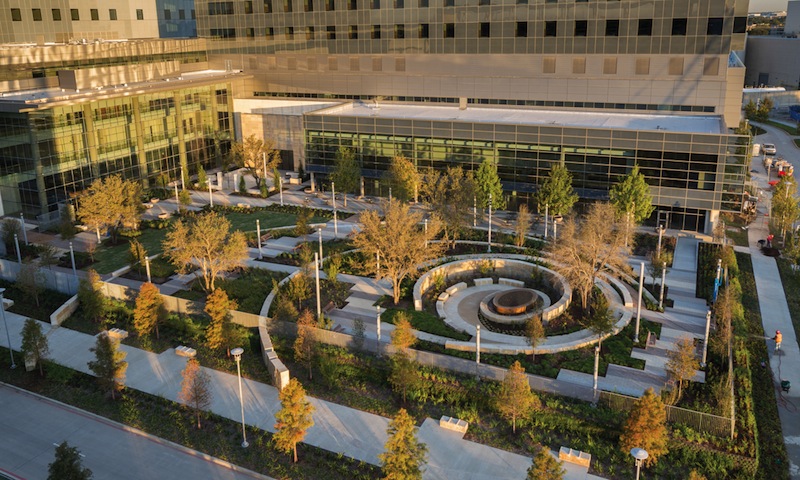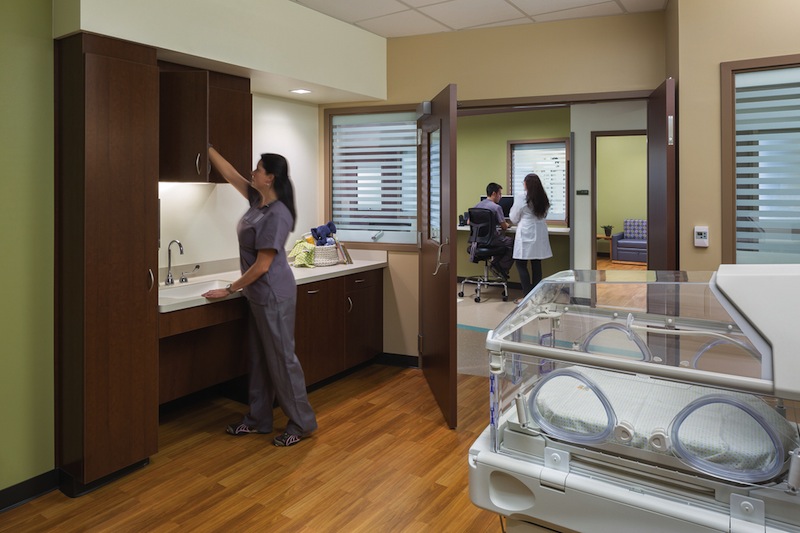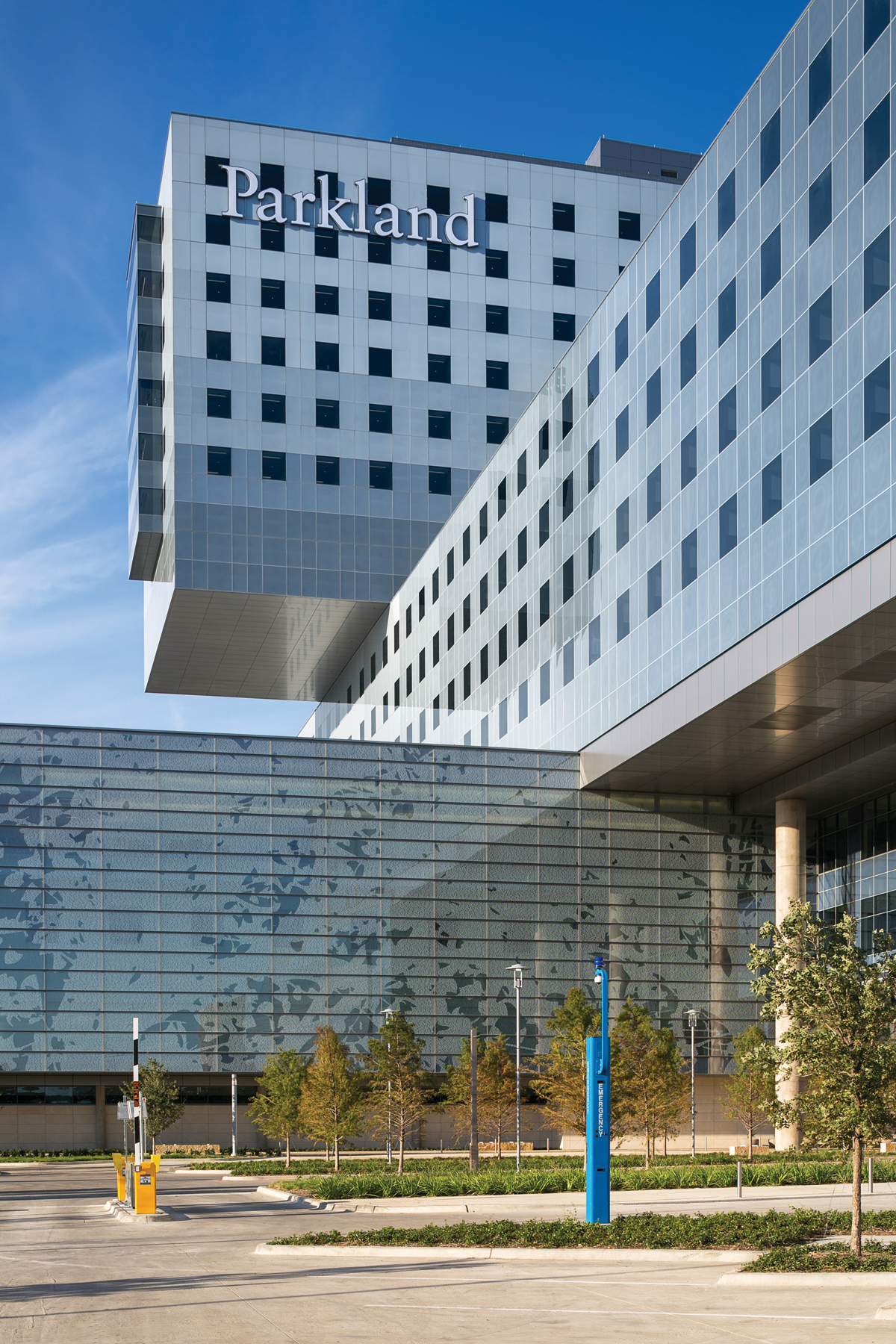The new Parkland Hospital is big. Check out the numbers: 862 private adult beds and 96 neonatal ICU beds. More than two million sf of space, and $1.27 billion in construction cost. Ten thousand employees. A hundred fifty minority/women/small business contractors. Five million man-hours in trades labor.
When it opens August 20, 30,000 visitors—speaking 77 languages—will stream through the new Parkland hospital daily, 140,000 people will seek care in its ED annually, and 16,000 babies will be born there every year.
As the largest public healthcare project in the country to be built in one phase, Parkland hospital “will serve as a standard for public healthcare development into the future,” said Lou Saksen, Senior Vice President for New Parkland Construction.
PROJECT SUMMARY
GOLD AWARD
Parkland Hospital
Dallas, TexasBUILDING TEAM
Submitting firm: HDR
Owner: Parkland Health & Hospital System
Architect, interior architect, master planner: HDR+Corgan Joint Venture
Programming consultant: Blue Cottage
Structural engineer: AG&E Structural Engenuity
MEP engineer: HDR
Civil engineer: Pacheco Koch
Electrical engineer (power): MEP Consulting Engineers, Inc.
CM: BARA (Balfour Beatty Construction, Austin Commercial, H.J. Russell & Company, and Azteca-Omega Group joint venture)GENERAL INFORMATION
Project size: 2.1 million sf
Construction cost: $1.27 billion
Construction time: October 2010 to October 2014
Delivery method: Collaborative project delivery (no contract)
MAKING THE COMPLEX SIMPLE
In 2008, Dallas County voters overwhelmingly approved a $747 million bond issue to replace the 1950s-era existing hospital. The design team of HDR+Corgan, a four-firm construction management group known as “BARA,” and programmer Blue Cottage were tasked with creating a master plan for the 64-acre medical campus and a building design for a LEED-NC 2009 Silver hospital. Ground was broken in May 2010; construction was completed last October.
What sounds like a relatively smooth execution belies the complexity of the project and the Herculean effort the Building Team made to make it seem easy.
Using what they called “collaborative project delivery”—an IPD with no contract—the team held visioning sessions to picture the future Parkland hospital from curbside to bedside. They brought in a consultant to coach them on teamwork. They co-located their workspace. They had estimators in place to make immediate evaluations of changes in costs. They set up a robust Patient & Family Advisory Council that had a real impact on program and design decisions.
They created three full-time “clinical liaison positions” staffed by veteran Parkland hospitial nurses, who acted as links to the medicine, surgery, and women’s services divisions. RNs “helped inform the entire design of the space,” said Kathy Harper, RN, MBA, EDAC, Parkland’s Director of Clinical Planning.
The team pulled out all the stops to solve a huge array of technical problems. They built mockups galore—a patient room, an OR, an NNICU room, a labor/delivery room—to gather feedback from hundreds of physicians, clinicians, and technicians. They prefabricated 750 bathroom units, 850 headboards, and three miles of MEP systems offsite.
When projections of ED use ballooned from a planned 100,000 visits a year to a possible 240,000, the team halted construction on the ED, redesigned it, and added a shelled bay of 12 exam rooms for future expansion.
When, in 2011, new hospital management asked for a “reexamination” of key design elements, the team enlarged ambulatory facilities on the main campus to meet anticipated demand. They reconfigured the radiology department into separate inpatient/outpatient units instead of a single unit as originally planned. They even redesigned the dietary kitchen so that patients could have 24-hour room service.
They standardized the ORs to allow for different types of equipment to be brought in, depending on the procedure. Conduits and cable trays were oversized. Floor-to-floor heights were bumped up to support future technologies.
According to Fred Cerise, MD, President/CEO, Parkland Health & Hospital System, “The legacy of this institution is cemented as an innovator in providing quality care for the medically underserved, as a leader in clinical expertise in specialties like burns and trauma, and as a pioneer of 21st-century transformational care processes.”
 A curvilinear garden with drought-resistant plantings helps fulfill the hospital’s objective to “put the park back in Parkland.” Public transportation to the hospital comes via the Dallas Area Rapid Transit Green Line and the new Parkland Station and Bus Transit Center. Patients and families access the parking facilities from the interior of the site; staff access parking from the perimeter.
A curvilinear garden with drought-resistant plantings helps fulfill the hospital’s objective to “put the park back in Parkland.” Public transportation to the hospital comes via the Dallas Area Rapid Transit Green Line and the new Parkland Station and Bus Transit Center. Patients and families access the parking facilities from the interior of the site; staff access parking from the perimeter.
 Evidence-based design and practices—exposure to natural light, decentralized nursing stations, healing gardens, noise reduction, soft lighting, etc.—play a significant role at Parkland. The neonatal ICU will be a test site for various EBD strategies, such as having an onsite pharmacy to reduce dosing errors. As a Pebble Project hospital, Parkland is engaged in multiple research projects, including wayfinding and reception-area seating arrangements.
Evidence-based design and practices—exposure to natural light, decentralized nursing stations, healing gardens, noise reduction, soft lighting, etc.—play a significant role at Parkland. The neonatal ICU will be a test site for various EBD strategies, such as having an onsite pharmacy to reduce dosing errors. As a Pebble Project hospital, Parkland is engaged in multiple research projects, including wayfinding and reception-area seating arrangements.
Related Stories
Healthcare Facilities | Oct 28, 2024
New surgical tower is largest addition to UNC Health campus in Chapel Hill
Construction on UNC Health’s North Carolina Surgical Hospital, the largest addition to the Chapel Hill campus since it was built in 1952, was recently completed. The seven-story, 375,000-sf structure houses 26 operating rooms, four of which are hybrid size to accommodate additional equipment and technology for newly developed procedures.
Healthcare Facilities | Oct 18, 2024
7 design lessons for future-proofing academic medical centers
HOK’s Paul Strohm and Scott Rawlings and Indiana University Health’s Jim Mladucky share strategies for planning and designing academic medical centers that remain impactful for generations to come.
Seismic Design | Oct 17, 2024
Calif. governor signs limited extension to hospital seismic retrofit mandate
Some California hospitals will have three additional years to comply with the state’s seismic retrofit mandate, after Gov. Gavin Newsom signed a bill extending the 2030 deadline.
Healthcare Facilities | Oct 9, 2024
How healthcare operations inform design
Amanda Fisher, Communications Specialist, shares how BWBR's personalized approach and specialized experience can make a meaningful impact to healthcare facilities.
Healthcare Facilities | Oct 8, 2024
Herzog & de Meuron completes Switzerland’s largest children’s hospital
The new University Children’s Hospital Zurich features 114 rooftop patient rooms designed like wooden cottages with their own roofs. The project also includes a research and teaching facility.
Hospital Design Trends | Sep 26, 2024
Hospital benchmarking survey shows sharp rise in hospital energy costs
Grumman|Butkus Associates, a firm of energy efficiency consultants and sustainable design engineers, recently released the results of its 2023 Hospital Energy and Water Benchmarking Survey, focusing on healthcare facilities’ resource usage trends and costs for calendar years 2021 and 2022.
Healthcare Facilities | Sep 19, 2024
New El Paso VA healthcare center includes 47 departments, brain and spinal cord injury treatment services
A new 492,000 sf Veterans Administration ambulatory care facility on the William Beaumont Army Medical Center campus near El Paso, Texas will include 47 medical departments and provide brain and spinal cord injury treatment services. A design-build team of Clark Construction, SmithGroup, and HKS is spearheading the project that recently broke ground with anticipated completion in 2028.
Healthcare Facilities | Sep 9, 2024
Exploring the cutting edge of neuroscience facility design
BWBR Communications Specialist Amanda Fisher shares the unique considerations and challenges of designing neuroscience facilities.
Curtain Wall | Aug 15, 2024
7 steps to investigating curtain wall leaks
It is common for significant curtain wall leakage to involve multiple variables. Therefore, a comprehensive multi-faceted investigation is required to determine the origin of leakage, according to building enclosure consultants Richard Aeck and John A. Rudisill with Rimkus.
Sponsored | Healthcare Facilities | Aug 8, 2024
U.S. healthcare building sector trends and innovations for 2024-2025
As new medicines, treatment regimens, and clinical protocols radically alter the medical world, facilities and building environments in which they take form are similarly evolving rapidly. Innovations and trends related to products, materials, assemblies, and building systems for the U.S. healthcare building sector have opened new avenues for better care delivery. Discussions with leading healthcare architecture, engineering, and construction (AEC) firms and owners-operators offer insights into some of the most promising directions. This course is worth 1.0 AIA/HSW learning unit.

















